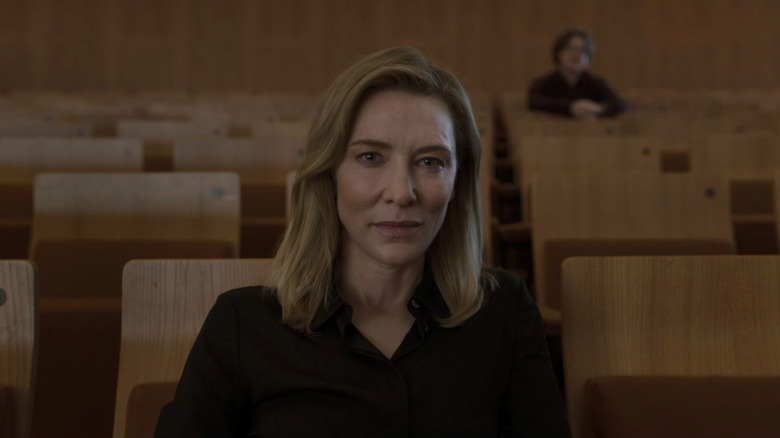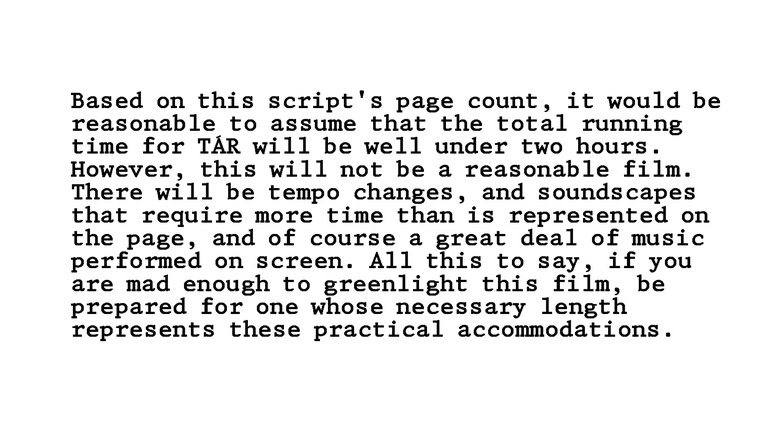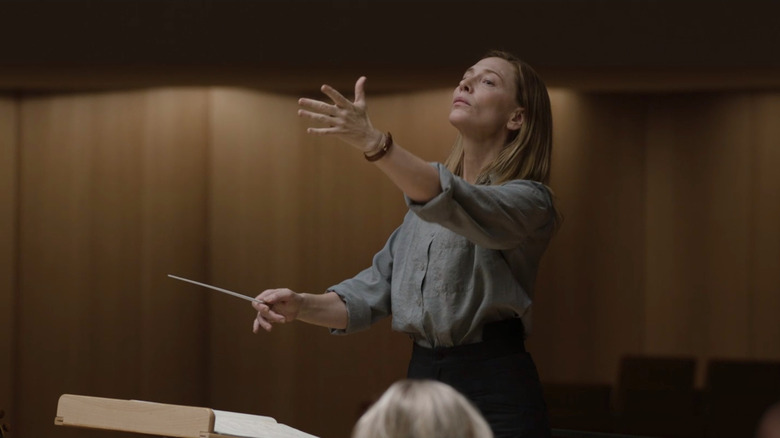Tar's Screenplay Featured A Warning To Financiers: 'This Will Not Be A Reasonable Film'
One of the first things you learn about writing screenplays is that, by and large, one page of your script will equate to about one minute of the running time. Obviously, there's some wiggle room in there, but that ends up being a pretty general rule. So, if you have a two-hour movie, chances are strong that the script will be about 120 pages long. Take Rian Johnson's screenplay for "Glass Onion: A Knives Out Mystery." It is 134 pages long, and the film cuts to its closing credits after 131 minutes. Pretty close.
Then there's "TÁR." Todd Field's first film in 16 years has a screenplay that has already won Best Screenplay awards from the Los Angeles Film Critics Association and the National Society of Film Critics and earned nominations from other associations and groups still waiting to announce a winner, which could very well be "TÁR." It is an entirely original, unusually structured character piece that blends several different genres to the point where very few people actually agree on how to describe or interpret the film. Though intensely focused on the titular character, exceptionally played by Cate Blanchett, "TÁR" feels like an epic, and it has a running time of 158 minutes to show for it. However, the screenplay itself is merely 92 pages. Seeing a disparity in page count and finished running time for a film that large is exceptionally rare, and Todd Field knows it. That is why when you turn to the first page of the screenplay you will not see "FADE IN" or a scene heading. You are going to see a warning to the folks at Focus Features that what is on the page can't fully contain everything "TÁR" needs to be.
Greenlight it, if you're 'mad enough'
How Todd Field came to write "TÁR" is one of those stories you never hear out of Hollywood. In the annual Directors Roundtable for The Hollywood Reporter, Field explains how Focus Features essentially gave him the ability to write anything his heart desired:
"Peter Kujawski and Kiska Higgs at Focus had said at the beginning of the pandemic — literally March 2020, the first lockdown — 'Just write whatever you want.' I said, 'Excuse me? I'm a trifle deaf in this ear.' You know, that was a very novel situation for me. It felt very strange and terrifying to try and live up and own that responsibility and the respect they had given me by offering me that opportunity."
He had the go-ahead to write whatever he wanted. That doesn't mean an automatic greenlight to make the movie he wrote. It's been 16 years since Field made a movie. He has ample experience writing spec scripts that go nowhere. Since he was given total freedom, he concocted a film that would feature both a tremendous amount of music and a quiet, eerie atmosphere with sequences that may take up one or two sentences on the page but last for minutes on end when visualized.
Because of this, Todd Field puts on the first page a disclaimer about the size of the screenplay being incredibly misleading. This isn't going to be a brisk 92-minute movie. This film is about a conductor, and Field can sense the vacillating rhythm that the movie needs to operate at and knows that isn't something words can exactly describe. Ultimately, Focus took heed of the warning and greenlit the picture, also giving Field final cut. There was no way this wasn't going to be what was in his head.
The page vs. the film
As a little demonstration of how the two mediums can be wildly different though tell the same story, let's look at one scene in particular: the first rehearsal of Mahler's 5th Symphony. On paper, this scene runs roughly a page and a half, which means it would usually be a 90-second scene. In the film, that scene runs nearly three and a half minutes. In terms of dialogue, nothing has been altered all that much, with the exception that she is speaking mostly in German with a little English rather than entirely in English. The big difference here is the music.
Todd Field can write "THIRD MOVEMENT. SCHERZO. BAR 448 TO 469," which doesn't even take up a full line on the page, but that is an extended piece of music we have to listen to. Music requires time, and in rehearsal, it requires repetition. This is how something that reads like it should be a quick minute-and-a-half scene ends up lasting nearly 20 minutes longer when performed and captured.
So many of the scenes are like this, and they aren't just the music scenes either. You have scenes of Lydia Tár silently walking around, investigating a noise she is hearing in her home that are one or two sentences when written out but need extended time to play out. When you add up all of these scenes from across the film together, that is how you end up with a movie that is about an hour longer than the screenplay presumes it to be. And it's that extra hour of pure mood that gives "TÁR" the ethereal, unusual quality that sets it apart from any other film from this year — or the past few years, for that matter.


